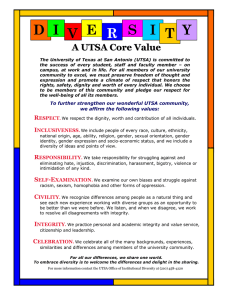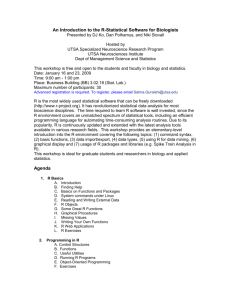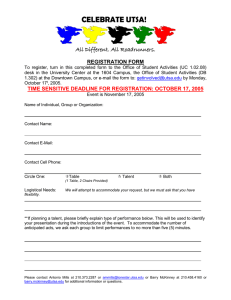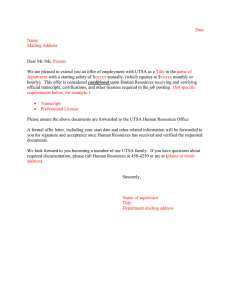– Phase One Superior Infrastructure Lenora Chapman & Michelle Stevenson Presenting
advertisement
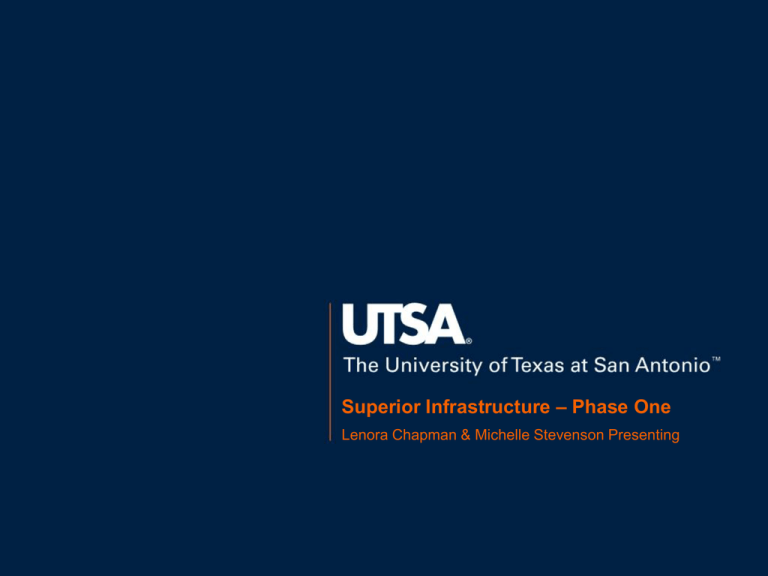
Superior Infrastructure – Phase One Lenora Chapman & Michelle Stevenson Presenting Physical, human, procedural, and financial Strengths (Selected) Strengths Strong commitment to become Tier One Foundational elements are in place Broad base of knowledgeable staff Simple, flexible and stable budget process with data driven revenue projections Master plan and effective oversight Preventive Maintenance Program for facilities Flexibility to establish decentralized IT structures and resources Opportunities and Threats (Selected) Opportunities Strong regional economy and unique demographics State and UT System funding mechanisms support some priorities External fundraising to provide additional revenue sources Public-private partnerships to leverage existing resources Best Practices (Selected) 1. Assemble a Task Force to review budget allocation models Sample metrics: U’s using the following models-incremental, zero-based, formula based, performance based, responsibility center management, and hybrid 2. Create a built environment that is both visually attractive and functional and that is flexible to meet multiple needs Sample metrics: APPA Award for Excellence, Facilities Condition Index 3. Formally engage in continuous review and improvement of business processes, adjusting for university growth and strategic direction(s) Benchmark: Emory U, U of Illinois 4. Establish an institutional mechanism to lead, communicate, and manage change Benchmark: Members of the Network for Change and Continuous Improvement Organization Key Recommendations (Selected) 1. Adopt a new budget allocation model that aligns limited resources with UTSA strategic goals 2. Allocate resources needed to attain state-of-the-art facilities 3. Establish a Business Process Improvement Governance structure and office 4. Designate a position or organizational unit that is responsible for leading the university in change management. 5. Establish a Technology Steering Committee charged to identify ways to enhance technology infrastructure and services using innovative solutions for research computing, course delivery, and classroom equipment. UTSA can refine the allocation of limited resources Expected timeline: 3 years Analyze and Plan Integrate, Train, Guide Adopt a Hybrid Model for Budget Allocation Budget allocation should: 1. align resources with UTSA priorities 2. be supported by reliable data and analysis 3. provide budgetary transparency 4. incentivize revenue growth and cost effectiveness 5. provide fiscal accountability and resource management UTSA can enhance campus facilities Success = Build + renew + maintain Conduct a comprehensive facility condition & needs assessment Establish capital renewal plan to meet funding requirements Fully fund facilities operations to eliminate $500K+ deficit Complete landscape master plan, pavement and lighting assessment, & conservation plan UTSA can optimize business processes UTSA can advance administrative excellence Change Management is Critical Step 2: Designate Leader/ Unit Step 1: Task Force Step 3: Gather UTSA data Step 4: Benchmark Change Management Establish, implement, and oversee a uniform methodology to communicate and manage change at UTSA Step 5: Develop & Implement at UTSA UTSA can be a leader in technology infrastructure Develop a long-term strategy to assess and meet UTSA strategic goals. Critical elements include: • Focus on both physical infrastructure and support services • Evaluate and address needs for research computing, classrooms, teaching laboratories, online & hybrid courses, and business applications that support these functions • Provide organizational support to college-level technical staff
